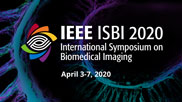Collection:

Deformable medial modeling is an approach to extracting clinically useful features of the morphological skeleton of anatomical structures in medical images. Similar to any deformable modeling technique, it requires a pre-defined model, or synthetic skeleton, of a class of shapes before modeling new instances of that class. The creation of synthetic skeletons often requires manual interaction, and the deformation of the synthetic skeleton to new target geometries is prone to registration errors if not well initialized. This work presents a fully automated method for creating synthetic skeletons (i.e., 3D boundary meshes with medial links) for flat, oblong shapes that are homeomorphic to a sphere. The method rotationally cross-sections the 3D shape, approximates a 2D medial model in each cross-section, and then defines edges between nodes of neighboring slices to create a regularly sampled 3D boundary mesh. In this study, we demonstrate the method on 62 segmentations of placentas in first-trimester 3D ultrasound images and evaluate its compatibility and representational accuracy with an existing deformable modeling method. The method may lead to extraction of new clinically meaningful features of placenta geometry, as well as facilitate other applications of deformable medial modeling in medical image analysis.
- IEEE MemberUS $11.00
- Society MemberUS $0.00
- IEEE Student MemberUS $11.00
- Non-IEEE MemberUS $15.00
Videos in this product
Automated Meshing of Anatomical Shapes for Deformable Medial Modeling: Application to the Placenta in 3d Ultrasound
Deformable medial modeling is an approach to extracting clinically useful features of the morphological skeleton of anatomical structures in medical images. Similar to any deformable modeling technique, it requires a pre-defined model, or synthetic skeleton, of a class of shapes before modeling new instances of that class. The creation of synthetic skeletons often requires manual interaction, and the deformation of the synthetic skeleton to new target geometries is prone to registration errors if not well initialized. This work presents a fully automated method for creating synthetic skeletons (i.e., 3D boundary meshes with medial links) for flat, oblong shapes that are homeomorphic to a sphere. The method rotationally cross-sections the 3D shape, approximates a 2D medial model in each cross-section, and then defines edges between nodes of neighboring slices to create a regularly sampled 3D boundary mesh. In this study, we demonstrate the method on 62 segmentations of placentas in first-trimester 3D ultrasound images and evaluate its compatibility and representational accuracy with an existing deformable modeling method. The method may lead to extraction of new clinically meaningful features of placenta geometry, as well as facilitate other applications of deformable medial modeling in medical image analysis.
 Cart
Cart Create Account
Create Account Sign In
Sign In
